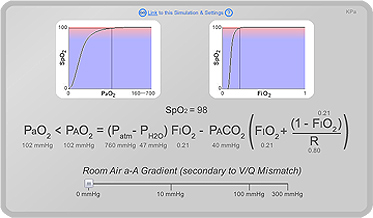
Complete Alveolar Gas Equation (AGE) Interactive Model
This interactive model uses dynamic plots to illustrate the alveolar gas equation (AGE) at steady state. Users can adjust R (respiratory quotient), PACO2 (alveolar partial pressure of carbon dioxide), Patm (barometric pressure), FiO2 (fraction of inspired oxygen), and PaO2 (a-A gradient) by clicking on their symbols in the equation and dragging the sliders on the slider bars that subsequently appear below. The numerical values below each symbol in the alveolar gas equation update as a slider is dragged. Assuming that PAO2 and arterial partial pressure of oxygen (PaO2) are similar, the oxyhemoglobin dissociation curve is used to correlate FiO2 to SpO2. The border around the simulation becomes red when SpO2 becomes less than 75. The PaO2 (a-A gradient) can be adjusted when FiO2 is air. FiO2 can be adjusted when the a-A gradient is small. A companion wiki page describes how supplemental oxygen may prevent detection of hypoventilation by pulse oximetry. |
|||||
The Alveolar Gas Equation (AGE) interactive model was developed with the financial support of our friends, Mr. James H. Lybass and his dear wife, Mrs. Joh-Nana Lybass. We appreciate their sincere commitment to the UF College of Medicine's Department of Anesthesiology along with their belief in the future of web-based patient simulation and its unbelievable impact on the future of worldwide education. |
|||||
